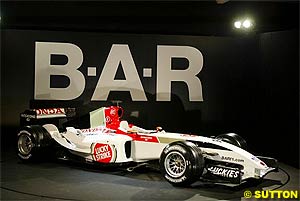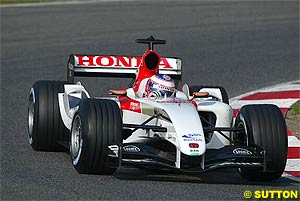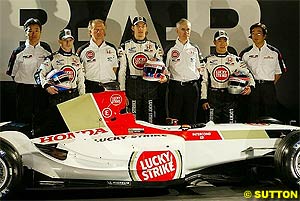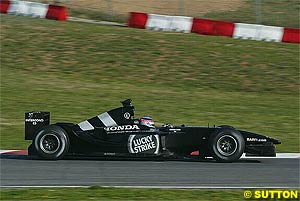
Atlas F1 Magazine Writer
After five seasons in the doldrums, 2004 sees BAR-Honda having all the right elements in place to make the big jump to the top of the Formula One field, and the team has made no secret of their ambitious goals for the year. After attending last Sunday's launch in Barcelona, Atlas F1's Dieter Rencken reviews BAR's chances of finally delivering the goods
Since then, of course, the team has been through much turmoil. The first season was point-less and blighted by bickering between everybody and anybody; the second brought Honda engines, 20 points, fifth in the championship and little else; the next, two podiums, but three points and a championship placing less.
In the process the outfit had gone overwhelmingly over every budget parameter set by paymaster and majority shareholder British American Tobacco whilst delivering, frankly, underwhelming results. In fact, on a bang per buck basis, BAR was pretty much bottom of the bundle.
By the launch of the BAR 004 (in December 2001) Craig Pollock - founder, team principal and manager to Williams' 1997 World Champion Jacques Villeneuve around whom the team was built - was gone, replaced by David Richards, who, in turn, drew an executive team from, predominantly, his Prodrive company. The operation's Subaru World Rally Team, then and now, enjoyed a close (and winning) relationship with BAT via its 555 cigarette brand, and Richards had headed up Benetton's F1 operation in 1999. So, the synergies were there, and things looked pretty good.
Richards brought in Nick Fry as Managing Director, and gave Hugh Chambers the top marketing job. Both held similar positions at Prodrive, and the BAR responsibilities were complementary to those. At the same time the headcount was pruned, cutting numbers across all departments to 360. But, an F1 outfit with winning aspirations cannot survive on an average of 180 people per car entered (or ten per car race in 2004), so a creative, effective plot was devised to bridge the staffing gap. Actually, make that two plots of equal creativity - both of which more anon.
The Computational Fluid Dynamics expert was, of course, too late to influence the basics of the 004, but the next car was pure Willis: logical in design and exquisite in execution. It returned BAR-Honda to fifth in the championship; more importantly it gave Button, in his maiden season with the team after two character-building years at Renault and his Williams debut, a feel for the lead of an F1 race... on wet tarmac. The young Brit, then still only 23 despite his 65 Grand Prix starts, led the US Grand Prix and seemed poised for a certain first podium when mechanical misfortune intervened.
At the time rumours were rife that BAR was negotiating an 'out' on the tyre front (notwithstanding placing second Bridgestone team in the final standings), in order to switch to Michelin. It was a far-sighted move: Sauber as, effectively if not officially, Ferrari's B-team - and BAR's closest championship challenger in 2003 - would run similar suspension set-ups and tyre compounds to the Red Team, plus the Swiss team was expected to swap test drivers with Maranello, leaving BAR to fend for itself in the very hectic midfield. If, however, it stayed in the midfield…
Why the doubt? Well, Formula One has this inbred of worshipping triple seasons ('in the first season we score points, in the second we challenge for podiums, in the third we go for wins…' goes the general F1 line). And, 2004 IS Willis' third year with BAR, with every previous season since his joining seeing appreciable gains in performance over the direct opposition despite the obvious disruptions of a young team constantly being reborn, one constantly torn apart by memories of what should have been and dreams of what could have been.
Of course, to finish first you first have to finish, and the team has been hard at work in this regard. First, it built the 2004 Concept Car, which ran the front of 005 with the complete back-end of this year's car. Was it successful? Was it, heck! Twice in the past month or so Jens slaughtered Barcelona's record; once in the past week he has, with 006, lowered the Catalan circuit's target times. Then, just yesterday, Tuesday, Takuma Sato, newly elevated to race driver from primary test duties in 2003, bettered the lot with the 005 CC.
As for reliability, Willis admitted to mechanical maladies in December, but quickly confirmed that the reasons had been isolated and sorted. "We had five engine failures in December, but in four of the instances it was the identical problem, which Honda has repaired. The fifth was a build error. In fact, subsequently we were the first team to run five engines up to 800 kilometres, so the problems seem sorted…"
Otmar Szafnauer, Vice President for Honda's F1 effort, too, pronounced himself quietly satisfied with his company's progress. He confirmed Willis' assertion, adding that Honda's triple-target of 800-kilometre engine life without reduction of revs (for which read power) whilst reducing weight "significantly" had been met.
That sort of reliability is vital in the pre-season, for it allows drivers to pile on miles. Button and third driver Anthony Davidson - looking forward to learning all circuits as Friday tester - admitted to doing more testing since Japan last year than in the whole of the 2003 season. The new engine regulations have, obviously, aided, as down times due to engine changes are drastically reduced.
Willis estimates that the team has "done something like 50% more testing so far than we had done by Melbourne last year, and we have almost the same amount testing again. In fact, we will have done three times as much testing as last year before we get to the first race."
Taku Sato, surely Honda's homeland's best yet hope of being its first-ever Grand Prix winner, has matured into a fast driver not to be intimidated on the day. His performance at Suzuka as stand-in for the departing Villeneuve (of whom not a word was said at the launch) was both steely and stylish, and bodes well for his coming campaign. Plus, having a driver line-up known for at least a season to the team - as are Button, Sato and Davidson - gives further ticks in the 'plus' column.
What, then, about BAR's physical readiness to make a step up to regular podiums and occasional wins? Running improvements to its wind tunnel, which, despite being five years old, has, according to Willis, "certain features that make it interesting to use", are presently being executed. (Fry admitted to signing off budget approvals for substantial upgrades to the Brackley tunnel a few days before the launch. The enhancements should be in place by July, with disruptions to workflows already planned for.)
On the accommodation side, little-known, long-term lease agreements for the balance of the neighbouring ex-Reynard facilities - unused since the race car constructor went into liquidation two years ago - have been agreed with their managing agents. Adrian Reynard, now running a similar wind tunnel of his own in the US, was present at a BAR launch for the first time in three years, and estimated that "the team has more than doubled its available floor space through the rentals."
All this ties in rather neatly with the establishment of BAR's self-contained R&D centre. In addition to approximately 25 Honda chassis and drive-train engineers seconded to BAR as part of ongoing research and development programmes, BAR has established a think-tank known as The Pure Group - not be confused with Pure Racing, the team's in-house publication.
The Group consists, according to Fry, of approximately 100 engineers - clustered in computational fluid dynamics (25 staffers), composite fabrication and machining (30-odd), pattern-making (again, 30-ish) divisions, plus specialist electronics, specialist paint and decaling areas. It allows BAR access to in-house specialists on a consultancy basis, returning to their formal area of employment to pursue outside projects when not required by the Formula One team.
Isn't BAR robbing Peter to pay Paul in terms of headcounts, then? "Not really," says Fry, "you wouldn't really need 25 people in our CFD activity only to support a Formula One team, probably only about ten; in our composite activities we have a core composite facility inside BAR, and a machining facility which can do a lot of outside work for other race car companies outside when not required by BAR. The same with pattern-making and the paint area, which does all Prodrive's painting."
But, the salient issue, says Fry, is that the Group generates revenue sources over and above traditional sponsorship streams, particularly if intellectual properties derived from research projects are brought to market. "It is something F1 has to look at as traditional streams close on us, and probably something that other teams have not really looked at yet, but will need to in future."
What sort of external, non-motor racing projects does the Group undertake? "We've done some work for pharmaceutical companies, inhalers for asthmatics, for example. The dosage and flow of air. Learning from doing so via CFD or whatever can feed back into our racing design."
Any team which researches asthma dosages to break lap records really is a breath of fresh air. And, fresh air is just what Button and Sato will wish to put between them and the rest. Although the team certainly isn't threatening so - it has learned well from past mistakes - it could well happen at least once this season.
Remember when British American Racing hit Formula One in 1999? How BAR went with brash, zippered colours which allowed it to circumvent FIA regulations and advertise two cigarette brands simultaneously; above all, remember how it 'threatened' to win its first race - with ancient Supertec power, at that?
 (It actually wasn't quite like that: then-Technical Director Adrian Reynard was asked whether he thought the BAR 001 could continue his tradition of winning its first race, and Reynard replied that he'd like to think so. But, with the new boys on the block having stripped the popular Tyrrell team of its entry rights, then chucking the rest away, F1 was ready to believe anything of BAR, and so the damaging rumour started…)
(It actually wasn't quite like that: then-Technical Director Adrian Reynard was asked whether he thought the BAR 001 could continue his tradition of winning its first race, and Reynard replied that he'd like to think so. But, with the new boys on the block having stripped the popular Tyrrell team of its entry rights, then chucking the rest away, F1 was ready to believe anything of BAR, and so the damaging rumour started…)
 Virtually Pollock's last act for the team he had founded was the employment of Geoffrey Willis, fresh from being 50% of Williams' design double-act (with Gavin Fisher), as Technical Director. So, okay, their cars had yet to win a championship, but they had invariably run at the sharp end - even with Supertec or nascent BMW power. Plus, whilst at Williams, Willis had worked closely with Jenson Button and Michelin in 2000, both factors that would prove fortuitous a few seasons down the track.
Virtually Pollock's last act for the team he had founded was the employment of Geoffrey Willis, fresh from being 50% of Williams' design double-act (with Gavin Fisher), as Technical Director. So, okay, their cars had yet to win a championship, but they had invariably run at the sharp end - even with Supertec or nascent BMW power. Plus, whilst at Williams, Willis had worked closely with Jenson Button and Michelin in 2000, both factors that would prove fortuitous a few seasons down the track.
 Sure, in 2003 podiums were conspicuous by their absence, but forget not that the three stairs beckoned on at least three occasions, and only mechanical misfortune prevented Button's first-ever podium, or Jacques Villeneuve's third for the team. So, podiums were, in 2003, a distinct possibility, if not a pointed reality.
Sure, in 2003 podiums were conspicuous by their absence, but forget not that the three stairs beckoned on at least three occasions, and only mechanical misfortune prevented Button's first-ever podium, or Jacques Villeneuve's third for the team. So, podiums were, in 2003, a distinct possibility, if not a pointed reality.
 Nothing wrong with the 006, Honda's RA004E, or the triple driver line-up, then. Tyres? Would anybody dispute the 2004 potential of the French company, which has, of late, worked very closely with BAR chassis and set-up engineers?
Nothing wrong with the 006, Honda's RA004E, or the triple driver line-up, then. Tyres? Would anybody dispute the 2004 potential of the French company, which has, of late, worked very closely with BAR chassis and set-up engineers?
 The Group, for example, developed the machined composites transmission casings upon which Willis is pinning so much hope; it also played important roles in developing electronics suites and systems - over twenty at last count. Here it worked in conjunction with Honda's robotics boffin, who developed the company's ASIMO robot - the most sophisticated robot in the world according to Szafnauer, and one which can stand and walk independently, walk up uneven steps, calculate distances and take verbal commands and react accordingly.
The Group, for example, developed the machined composites transmission casings upon which Willis is pinning so much hope; it also played important roles in developing electronics suites and systems - over twenty at last count. Here it worked in conjunction with Honda's robotics boffin, who developed the company's ASIMO robot - the most sophisticated robot in the world according to Szafnauer, and one which can stand and walk independently, walk up uneven steps, calculate distances and take verbal commands and react accordingly.
Please Contact Us for permission to republish this or any other material from Atlas F1.
|
Volume 10, Issue 5
Articles
Stand and Deliver
Technical Analysis: BAR 006
Technical Analysis: Renault R24
2004 SuperStats: Winter Testing
2004 Countdown: Facts & Stats
Columns
The Fuel Stop
The F1 Trivia Quiz
On the Road
Elsewhere in Racing
> Homepage |